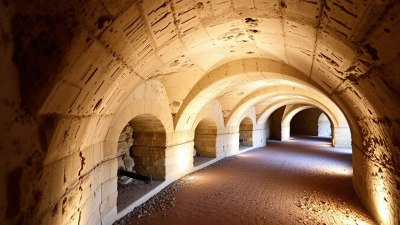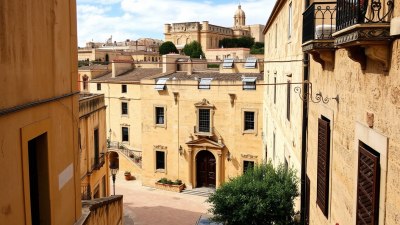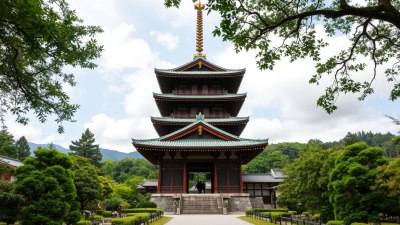Luxembourg City’s Casemates: Exploring Fortress Tunnels
Discover the fascinating history and architecture of Luxembourg City's Casemates tunnels, a UNESCO World Heritage site.

Image created with Flux Schnell
Luxembourg City, known for its fortified walls and rich heritage, is home to the extraordinary Casemates du Bock, a series of tunnels that delve deep into the heart of the city. Initially constructed in the 17th century, these fortifications were crucial for the defense of Luxembourg City, serving as a military stronghold for many years. As you explore the Casemates, you will uncover the strategic significance they held throughout various conflicts and their role in shaping the city's historical landscape.
The Casemates were designed to house soldiers and necessary supplies during sieges, ensuring a quick response to threats. They offered protection while maintaining a vantage point over the surrounding area. The tunnels stretch over 23 kilometers, intricately carved into the rock, and feature chambers, storage areas, and lookout posts. Their structure showcases the impressive engineering abilities of the time, with high vaulted ceilings and thick walls that could withstand cannon fire.
More than just military fortifications, the Casemates played a key role in the daily life of Luxembourg's residents. They became a refuge during wars, where civilians sought safety from bombardments. The tunnels have also served various functions over the centuries, from storage facilities to escape routes for those wishing to leave the city unnoticed.
The UNESCO World Heritage Status
In 1994, the Casemates were recognized as a UNESCO World Heritage site, celebrating their historical significance and architectural uniqueness. This designation has led to increased preservation efforts, ensuring that visitors can continue to appreciate the tunnels' history and beauty for generations to come. By protecting the Casemates, Luxembourg strives to maintain a connection to its past while also promoting tourism and education about the city's unique heritage.
As you walk through the cool, dimly-lit passageways, it’s easy to imagine the soldiers who once patrolled these tunnels, alert to the sound of distant cannon fire. The echo of footsteps serves as a reminder of the many stories held within these walls. Visitors can explore various sections of the Casemates, with informative plaques providing context about their construction, usage, and restoration.
One of the key highlights of the Casemates is the stunning view they offer of the city's landscape. Many entrances open to breathtaking panoramas above the Alzette River, providing a perfect spot for photography enthusiasts and a chance to appreciate the city from an entirely new perspective. The juxtaposition of the old fortifications with the modern skyline of Luxembourg City is a sight to behold.
Visiting the Casemates
For those wishing to visit the Casemates, the site is open year-round, though specific hours may vary by season. Guided tours are available, providing deeper insights into the history and architecture of the tunnels. These tours are highly recommended for history buffs and casual visitors alike, as knowledgeable guides share fascinating stories, legends, and facts that bring the tunnels to life.
Traveling through the tunnels can take between 30 minutes to an hour, depending on your pace and interests. It’s advisable to wear comfortable shoes, as the pathways may be uneven and include some steep sections. The tunnels are also relatively cool, making them a welcome respite on hot summer days.
Accessibility and Practical Information
While the Casemates are generally accessible, some areas may pose challenges for visitors with mobility impairments. It's advisable to check in advance for specific accessibility information. There are facilities such as restrooms and souvenir shops nearby, enhancing the visitor experience. Additionally, consider combining your Casemates visit with a stroll around the nearby Old Town, a UNESCO World Heritage site itself, with its picturesque streets, historic buildings, and delightful cafés.
As a historical landmark, the Casemates attract many tourists and locals alike. To avoid the crowds, consider visiting during weekdays or early in the morning. This allows for a more intimate experience, as you can take your time exploring the fascinating nooks and crannies of the tunnels.
Connecting to Luxembourg's Broader History
The history of the Casemates is intertwined with that of Luxembourg itself. As one of the last remaining fortified cities in Europe, Luxembourg City reflects centuries of strategic military and political importance. The Casemates were part of a larger network of defenses, including heavily fortified barriers, ramparts, and watchtowers that once surrounded the entire city. Notably, the Vauban-style alterations made in the 18th century enhanced their capabilities and adaptability.
Throughout its history, Luxembourg City endured numerous sieges and occupations, which only amplified the need for a robust defense system. The strategic location at the crossroads of Europe made it a target and an asset for various powers, including the Spanish, French, and Prussians. Each iteration of control brought modifications to the fortifications, adding layers to Luxembourg's complex and multifaceted history.
The Casemates stand as a testament to the resilience of Luxembourg City through adversity. They serve as a reminder of a time when warfare dictated the fortunes of cities and demonstrated the ability of societies to adapt and evolve. Now, as a symbol of peace and heritage, the Casemates invite visitors to reflect on the past while encouraging a deeper understanding of the present.
Cultural Significance and Legacy
Today, the Casemates are not only a window into military history but also an embodiment of Luxembourg's cultural identity. They inspire artists, writers, and historians, providing subjects for exploration and inspiration. The tunnels play a role in various cultural events, performances, and exhibitions, fostering community engagement and education.
Moreover, the Casemates contribute to Luxembourg's tourism appeal, attracting visitors from around the world eager to learn about the country's unique blend of history and modernity. The tunnels have become ingrained in the cultural landscape, enhancing local pride and fostering a sense of belonging among residents.
Conservation Efforts and Future Prospects
Continued preservation and conservation efforts are vital in maintaining the integrity of the Casemates. Environmental factors, such as erosion and urban development, pose challenges to the structural stability of these historic tunnels. Authorities are actively working on maintenance programs to ensure their preservation, utilizing modern technology while respecting traditional building practices.
The future of the Casemates looks promising as educational programs encourage local schools to engage with their history. By fostering a sense of ownership and responsibility for cultural heritage among younger generations, Luxembourg is ensuring the longevity of the Casemates as a vital part of the nation's identity.
Luxembourg City's Casemates are more than just a series of tunnels; they are an enduring symbol of the city's rich history and resilience. A visit to the Casemates offers a unique opportunity to explore a vital part of Luxembourg's heritage while appreciating the stunning beauty of the city around them. The blend of military architecture, natural landscapes, and vibrant city life creates an experience that resonates with all who traverse these historical pathways. For anyone traveling to Luxembourg, a journey through the Casemates should undoubtedly top the itinerary, as they encapsulate the spirit of a city that has embraced its past while looking forward to a promising future.











